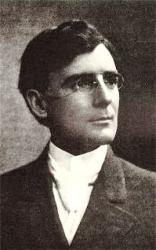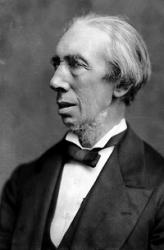Planning worship?
Check out our sister site, ZeteoSearch.org,
for 20+ additional resources related to your search.
- |
User Links
Person Results
William Henry Monk

1823 - 1889 Person Name: William H. Monk Composer of "NOONDAY" in College Hymnal William H. Monk (b. Brompton, London, England, 1823; d. London, 1889) is best known for his music editing of Hymns Ancient and Modern (1861, 1868; 1875, and 1889 editions). He also adapted music from plainsong and added accompaniments for Introits for Use Throughout the Year, a book issued with that famous hymnal. Beginning in his teenage years, Monk held a number of musical positions. He became choirmaster at King's College in London in 1847 and was organist and choirmaster at St. Matthias, Stoke Newington, from 1852 to 1889, where he was influenced by the Oxford Movement. At St. Matthias, Monk also began daily choral services with the choir leading the congregation in music chosen according to the church year, including psalms chanted to plainsong. He composed over fifty hymn tunes and edited The Scottish Hymnal (1872 edition) and Wordsworth's Hymns for the Holy Year (1862) as well as the periodical Parish Choir (1840-1851).
Bert Polman
William Henry Monk
W. Howard Doane

1832 - 1915 Person Name: W. H. Doane Composer of "[While the sun is shining]" in Sunny-Side Songs for Sunday Schools An industrialist and philanthropist, William H. Doane (b. Preston, CT, 1832; d. South Orange, NJ, 1915), was also a staunch supporter of evangelistic campaigns and a prolific writer of hymn tunes. He was head of a large woodworking machinery plant in Cincinnati and a civic leader in that city. He showed his devotion to the church by supporting the work of the evangelistic team of Dwight L. Moody and Ira D. Sankey and by endowing Moody Bible Institute in Chicago and Denison University in Granville, Ohio. An amateur composer, Doane wrote over twenty-two hundred hymn and gospel song tunes, and he edited over forty songbooks.
Bert Polman
============
Doane, William Howard, p. 304, he was born Feb. 3, 1832. His first Sunday School hymn-book was Sabbath Gems published in 1861. He has composed about 1000 tunes, songs, anthems, &c. He has written but few hymns. Of these "No one knows but Jesus," "Precious Saviour, dearest Friend," and "Saviour, like a bird to Thee," are noted in Burrage's Baptist Hymn Writers. 1888, p. 557.
--John Julian, Dictionary of Hymnology, Appendix, Part II (1907)
===================
Doane, W. H. (William Howard), born in Preston, Connecticut, 1831, and educated for the musical profession by eminent American and German masters. He has had for years the superintendence of a large Baptist Sunday School in Cincinnati, Ohio, where he resides. Although not a hymnwriter, the wonderful success which has attended his musical setting of numerous American hymns, and the number of his musical editions of hymnbooks for Sunday Schools and evangelistic purposes, bring him within the sphere of hymnological literature. Amongst his collections we have:—
(1) Silver Spray, 1868; (2) Pure Gold, 1877; (3) Royal Diadem, 1873; (4) Welcome Tidings, 1877; (5) Brightest and Best, 1875; (6) Fountain of Song; (7) Songs of Devotion, 1870; (8) Temple Anthems, &c.
His most popular melodies include "Near the Cross," "Safe in the Arms of Jesus," "Pass me Not," "More Love to Thee," "Rescue the Perishing," "Tell me the Old, Old Story," &c.
- John Julian, Dictionary of Hymnology (1907)
W. Howard Doane
W. S. Pitts
1830 - 1918 Person Name: William Pitts Composer of "PRINCETHORPE" in Worship and Song William Savage Pitts MD USA 1830-1918. Born at Yates, NY, the son of Puritans, he was the 8th of nine children. He had musical ability from an early age, taking formal music lessons from a graduate of the Boston Handel & Hadyn Society. At age 19, he traveled with his family to Rock County, WI, where he worked as a rural music schoolteacher in Union, WI. He taught for several years, there and at singing schools, and for brass bands, composing much of their music. In 1857 he traveled to Fredericksburg, IA, to visit his fiancee, Ann Eliza Warren, a teacher. Along the way he stopped his horse-drawn wagon at Bradford, IA, to rest. He walked across a field and saw a picturesque wooded valley formed by the Cedar River. Viewing the spot, he envisioned a church building there. He couldn’’t get the image out of his mind. Returning home to WI, he wrote out the words to a poem about the envisioned scene, calling it “Church in the wildwood”, for his own sake. He was then at rest about it. In 1862, he was married in Union, WI, and he and his wife moved to Fredericksburg to be near her elderly parents. Upon returning to Iowa, Pitts stopped along the route at the same location he had five years before to see it again. He was surprised to see a little church being built, and being painted brown. He met with the builders and asked why it was being painted brown, finding out that it was the cheapest paint they could find.. money being tight. The church builders, learning about his poem written several years earlier, asked him to bring his church choir to the dedication and sing a dedicatory song. In 1863 he did so. This was the first time the song was sung in public. The Pitts remained at Fredersicksburg, IA, for 44 years and had five children: Nellie, Grace, Alice, William, and Kate. Pitts served as mayor of Fredericksburg for seven years, as school treasurer for 26 years, wrote a biographical local history, and was a Master Freemason. In 1865 Pitts moved to Chicago to enroll at Rush Medical College. While there, to pay expenses, he offered several songs he had written to a music publisher, who chose his song “Little brown church in the vale”, and he sold the rights to his song for $25. He completed medical school, graduating in 1868, but the song was largely forgotten for several decades. Pitts practiced medicine in Fredericksburg until 1906. His wife died in 1886, and he remarried to Martha Amelia Pierce Grannis in 1887. They moved to Clarion, IA, in 1906. She died in 1909. Pitts then moved to Brooklyn, NY, to be with his son, William, who was working for the U. S. War Department. Pitts joined Fredericksburg’s Baptist Church in 1871, then the Congregational Church in Clarion, IA, in 1906, and later the Dyker Heights Congregational Church in Brooklyn, NY, in 1909. He occasionally performed his most famous song. He died at Brooklyn, NY, but was buried in Fredericksburg, IA.
John Perry
W. S. Pitts
I. H. Meredith

1872 - 1962 Composer of "[While the sun is shining brightly in the sky]" in Sunday School Hymns No. 1 Pseudonyms
Charles C. Ackley (taken from his wife’s name, Clarissa Ackley Cowan)
Broughton Edwards
Floyd Engle (from his address on Floyd Street in Englewood Cliffs, New Jersey)
Arthur Grantley
Bruce Kennedy
See also Ackley, Chas. C. 1872-1962
See also Edwards, Broughton
I. H. Meredith
Samuel Smith
1821 - 1917 Person Name: Samuel Smith, b. 1821 Composer of "RUTH" in Church Hymns
Samuel Smith
T. Alfred Stowell
1831 - 1916 Person Name: Rev. T. A. Stowell Author of "While the sun is shining Brightly in the sky" in School and College Hymnal T. Alfred Stowell, M.A.; Queen’s College, Oxford; rector of Chorley; hon. canon of Manchester Cathedral; and rural dean of Leyland
=======================
Stowell, Thomas Alfred, M.A., son of Canon H. Stowell, was born at Salford, July 15, 1831. He was Bridgman Exhibitioner at Queen's College, Oxford, 1853, and B.A. in honours in 1855. Taking Holy Orders in 1857, he became Curate of Bolton, Diocese of Ripon, 1857-60; Incumbent of St. Stephen's, Bowling, Bradford, 1860-65; and then Rector of Christ Church, Salford, in succession to his father, 1865. He was also appointed Rural Dean of Salford in 1876, and Hon. Canon in Manchester Cathedral in 1879. Canon T. A. Stowell has published The Church Catechism simply and clearly explained, 1882, various Sermons, papers on Education, &c. Most of his hymns were written for the Anniversary Sermons of Christ Church Sunday Schools, Salford (nearly 2000 children), and include:—
1. Blessed Saviour, hear us when we cry. 1872.
2. Happy were those mothers. 1866.
3. In God's holy dwelling. 1873.
4. Lord, on Thy day, within Thy holy dwelling. 1877.
5. Lord, Thy children lowly bending. 1875.
6. My Saviour, be thou near me, When I lie down, &c. 1874.
7. O Jesus [Saviour] we have promised Henceforth to be Thine Own. Confirmation. 1877.
8. Sweet day of rest which God has given. Sunday. 1868.
9. While the sun is shining. Work. 1869.
These 9 hymns are in Canon T. A. Stowell's 1877 ed. of his father's Selection and of these Nos. 3 and 9 are the most popular.
He is also the author of:—
10. Come, Christian youths and maidens. Sunday School Anniversary. In Mrs. Brock's Children's Hymn Book, 1881, and others.
11. Early the holy women came. Easter. In the Church Monthly, April, 1888.
12. Remember thy Creator. Youthful Piety. In the Church S. School Magazine , Feb. 1888.
13. Saviour, we are young and weak. The Christian Race. In Mrs. Brock's Children's Hymn Book, 1881.
Several of these are popular hymns for children, and will no doubt gradually come into somewhat extensive use.
-- John Julian, Dictionary of Hymnology (1907)
T. Alfred Stowell
Josiah Booth
1852 - 1930 Person Name: J. Booth Composer of "FARNSWORTH" in The Congregational Mission Hymnal Josiah Booth (27 March 1852 – 29 December 1929) was an English organist and composer, known chiefly for his hymn-tunes.
See also in:
Wikipedia
Josiah Booth
Thomas Morley
1845 - 1891 Composer of "DAVID" in The New Christian Hymnal Thomas Morley; b. Oxford, England, 1845; d. St. John, New Brunswick, 1891
Evangelical Lutheran Hymnal, 1908
Thomas Morley
George A. Macfarren

1813 - 1887 Person Name: George Alexander MacFarren (1813-1887) Composer of "ELLWOOD" in Carmina for the Sunday School and Social Worship George Alexander Macfarren, Mus. Doc.; b. London, 1813; d. London, 1887
Evangelical Lutheran Hymnal, 1908
=======================
Born: March 2, 1813, Westminster, England.
Died: October 31, 1887, St. Marylebone, England.
Buried: Hampstead Cemetery, London, England.
Brother of Walter Macfarren, George was a principal of the Royal Academy of Music; professor at Cambridge University; conductor at Covent Garden, London; program note writer for the Philharmonic Society; and editor of Handel and Purcell. He wrote 18 operas, 13 oratorios and cantatas, 9 symphonies, and 162 songs. He went blind in 1860, and was knighted in 1883.
Sources:
Frost, p. 681
Lightwood, p. 189
Nutter, p. 460
http://www.hymntime.com/tch/bio/m/a/c/macfarren_ga.htm
===============================
http://en.wikipedia.org/wiki/George_Alexander_Macfarren
George A. Macfarren


 My Starred Hymns
My Starred Hymns


